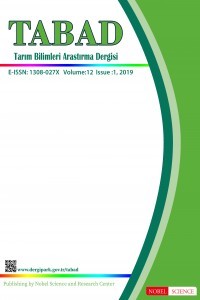Yetiştirme Tekniğinin ve Hasat Periyodunun Kudret Narında (Momordica charantia L.) Bazı Meyve ve Tohum Özellikleri Üzerine Etkisi
Bu araştırma, kudret narı (Momordica charantia L.) bitkisinde yetiştirme tekniği olarak uygulanan budama ve tepe alımının, bitkilerin hasat periyoduna bağlı olarak meyve ve tohum özellikleri üzerindeki etkilerini belirlemek amacıyla Pazar/Rize koşullarında 2015 yılında yürütülmüştür. Serada yetiştirilen kudret narı fidelerinin tarlaya fidelenmesiyle deneme tesis edilmiştir. Bitkiler yeterli boya ulaştığında sırasıyla budama (kontrol, 0 dal, 2 dal ve 4 dal bırakma) ve tepe alımı (kontrol ve tepe alımı) uygulaması yapılmıştır. Bu çalışmada hasat periyoduna bağlı olarak meyve uzunluğu, meyve ağırlığı, meyve eti ağırlığı, meyvede tohum örtüsü ağırlığı, meyvede tohum sayısı, meyvede tohum verimi, tohum uzunluğu, tohum genişliği, tohum derinliği, meyvede suda çözünen kuru madde oranı ve titre edilebilir asitlik değerleri tespit edilmiştir. Araştırmada, hasat periyoduna bağlı olarak, tepe alımının sadece meyve uzunluğuna etkisi önemli (P<0.05) çıkarken; budama ile bırakılan dal sayısının incelenen özellikler üzerinde istatistiki anlamda bir etkisi olmamıştır. Bununla birlikte, hasat periyodunun meyve uzunluğu, meyve ağırlığı, meyve eti ağırlığı ve tohumu saran örtü ağırlığına etkisi çok önemli (P<0.01) çıkmıştır. Tohum özellikleri dikkate alındığında, hasat periyodunun tohum uzunluğuna etkisi önemli (P<0.05), tohum genişliğine etkisi ise çok önemli (P<0.01) çıkmıştır. Araştırma sonuçları ışığında, özellikle meyve uzunluğu ve meyve ağırlığı bakımından 2. hasat periyodunda diğerlerine göre daha nitelikli ürün elde edilebileceği tespit edilmiştir.
Anahtar Kelimeler:
Hasat periyodu, meyve, Momordica charantia
___
- [1] Anonim, 2016. Meteoroloji Genel Müdürlüğü İklim Verileri
- [2] CISIR, 1999. Karawila (Momordica charantia). Medicinal and aromatic plants series, Baudhaloka Mawatha, Colombo 7, Sri Lanka, Vol. 3, 36 p
- [3] Dimabuyu HB, Gonzaga, ZC, Lusanta DC, Mangmang JS, Capuno OB, Rogers GS. 2016. Reducing disease incidence and increasing productivity of ampalaya (Momordica charantia L.) through pruning and protected cultivation. Acta Hortic. 1128, 177-182
- [4] Duan C, Liu Z, Hong-wen Cui H. 2012. The Distribution and Application of Bitter Gourd in China. Cucurbit Genetics Cooperative Report (2010-2011). P: 67-68. Erişim Tarihi: 14.09.2017 http://cuke.hort.ncsu.edu/cgc/cgc3334/cgc3334-22.pdf
- [5] Fong WP, Poon YT, Wong TM, Mock JW, Ng TB, Wong RN, Yao QZ, Yeung HW. 1996. A highly efficient procedure for purifying the ribosome-inactivating proteins alpha- and beta-momorcharins from Momordica charantia seeds, N-terminal sequence comparison and establishment of their N-glycosidase activity. Life Science, 59(11):901-909
- [6] Grover JK, Yadav SP. 2004. Pharmacological actions and potential uses ofMomordicacharantia: a review Journal of Ethnopharmacology. 93(1):123-132
- [7] Jat GS, Singh B, Tomar BS, Singh J, Ram H, Kumar M. 2016. Seed yield and quality as influenced by growing conditions in hybrid seed production of bitter gourd (Momordica charantia L.) cv. Pusa Hybrid-1. Journal of Applied and Natural Science 8(4):2111-2115
- [8] Joseph B, Jini D. 2013. Antidiabetic effects of Momordia charantia (bitter melon) and its Medicinal potency. Asian Pacific Journal of Tropical Disease. 3(2):93-102
- [9] Kwatra D, Dandawate P, Padhye S, Anant S. 2016. Bitter Melon as a Therapy for Diabetes, Inflammation, and Cancer: a Panacea? Curr Pharmacol Rep (2):34-44
- [10] Lagunovschi-Luchian V, Vinatoru C, Zamfir B, Brat C, Tăpăloagă D, Radoi I. 2017. Studies and research regarding acclimatization and breeding of new vegetable plant, Momordica charantia at V.R.D.S. Buzău, România. European Biotechnology Thematic Network Association. The EuroBiotech Journal. 1(1):82-84
- [11] Lee SH, Jeong YS, Song J, Hwang KA, Noh GM, Hwang IG. 2016. Antioxidant Activity of Bitter Melon (Momordica charantia L.) at Different Maturation Stages. International Journal of Food Properties. online: 25 Oct 2016. http://www.tandfonline.com/doi/full/10.1080/10942912.2016.1237961
- [12] Manabe M, Takenaka R, Nakasa T, Okinaka O. 2003. Induction of antiinflammatory responses by dietary Momordica charantia L. (bitter gourd). Bioscience, Biotechnology, and Biochemistry, 67(12):2512-2517.
- [13] Morgan W, Midmore D. 2002. Bitter Melon in Australia. A report for the Rural Industries Research and Development Corporation. RIRDC Publication No 02/134, Printed by Union Offset. 29 p
- [14] Palada MC, Chang LC. 2003. Suggested Cultural Practices for Bitter Gourd. International Cooperators’ Guide, 5p
- [15] Pornsuriya P, Pornsuriya P, Numuen C. 2011. Phenotypic diversity and classification of Thai bitter melon (Momordica charantia L.) landraces from three provinces in central region of Thailand. Journal of Agricultural Technology 7(3): 849-856
- [16] Quintana EG, Mabesa RC, Mayuga IC, Aquino AT. 2001. Leaf yield response of ampalaya (Momordica charantia cv. Makiling) to some cultural management practices. Asian Agriculture Congress, Manila (Philippines), 24-27 Apr 2001. http://agris.fao.org/agris-search/search.do?recordID=PH2002000293.ç Erişim tarihi: 14.09.2017
- [17] Rafie AR, Mullins C. 2008. Greenhouse Bitter Melon Production in Southern Virginia. Proceedings of the Florida State Horticultural Society, 121:191-193.
- [18] Sarani M, Mehraban A, Ganjali HR. 2015. Effect of pruning and row distance on some characteristics in Karela. International Journal of Biosciences. 6(1):1-8
- [19] SAS Institute (1989-2002). The statistical discovery software, JMP Version 5
- [20] Savsatli Y, Seyis F. 2014. Effects of different plant¬ing frequency to some agricultural traits of bitter melon (Mo¬mordica charantia L.) grown in Rize ecological conditions. Turkish Journal of Agricultural and Natural Sciences, (1): 659-662
- [21] Singh UK, Singh D, Prasad VM, Kumar H, Umrao R. 2016. Performance and capital use efficiency of Bitter gourd (Momordica charantia L.) genotypes in their production. Res. Environ. Life Science, 9(6):672-675
- [22] Tan SP, Kha TC, Parks SE, Roach PD. 2015. Bitter melon (Momordica charantia L.) bioactive composition and health benefits: A review. Pages 181-202, Published online: 09 Jun 2015, http://www.tandfonline.com/doi/abs/10.1080/87559129.2015. 1057843
- [23] Yaldız G, Sekeroglu N, Kulak M, Demirkol G. 2014. Antimicrobial activity and agricultural properties of bitter melon (Momordica charantia L.) grown in northern parts of Turkey: a case study for adaptation. page 543-545, Published online: 21 Aug 2014. http://www.tandfonline.com/doi/full/10.1080/14786419.2014.949706?src=recsys
- Başlangıç: 2008
- Yayıncı: Nobel Bilim ve Araştırma Merkezi Limited
Sayıdaki Diğer Makaleler
Köylünün Alternatif Tarım ve Ulaşım Aracı: “Modern Eşek Patpat”
Yeni Nesil Bitki Islahı Yöntemleri (Moleküler Bitki Islahı) Bazı Avantaj & Dezavantajları
Yusuf ŞAVŞATLI, Fatih SEYİS, Mustafa AKBULUT, Muhammed ÇATAL, Nalan BAKOĞLU
Batı Akdeniz Bölgesi Yörüklerinin Bitkisel ve Hayvansal Üretim Faaliyetleri
